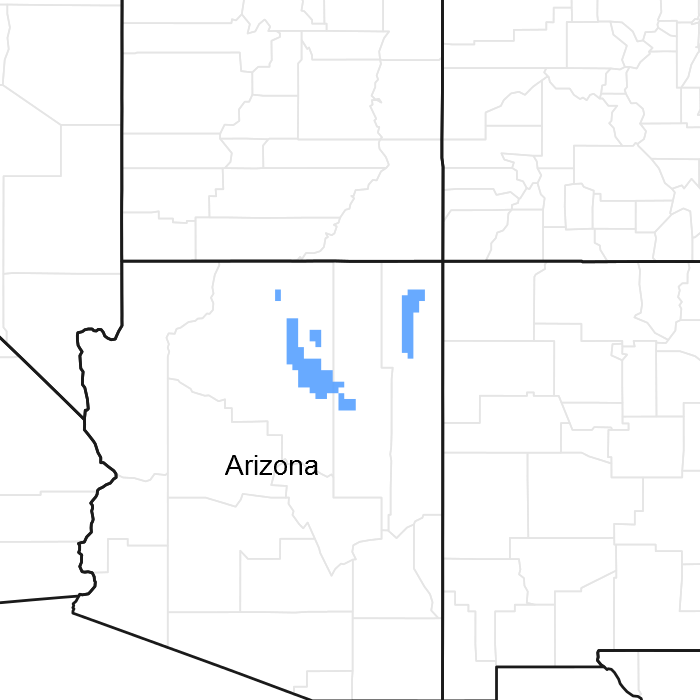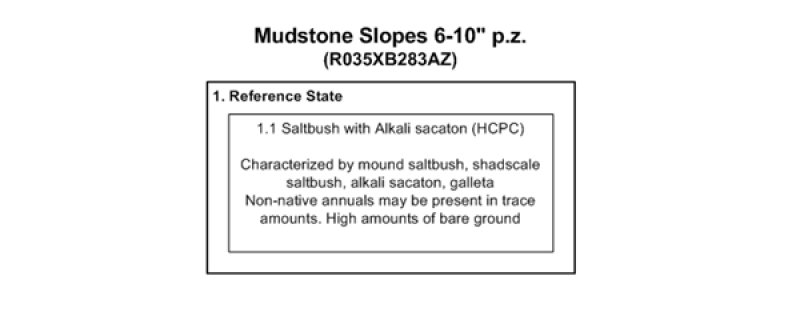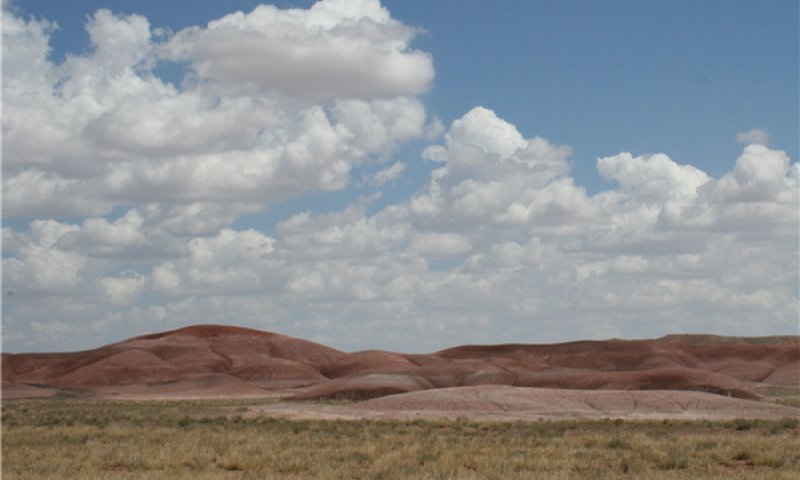

Natural Resources
Conservation Service
Ecological site R035XB283AZ
Mudstone Slopes 6-10" p.z.
Accessed: 12/08/2025
General information
Provisional. A provisional ecological site description has undergone quality control and quality assurance review. It contains a working state and transition model and enough information to identify the ecological site.

Figure 1. Mapped extent
Areas shown in blue indicate the maximum mapped extent of this ecological site. Other ecological sites likely occur within the highlighted areas. It is also possible for this ecological site to occur outside of highlighted areas if detailed soil survey has not been completed or recently updated.
MLRA notes
Major Land Resource Area (MLRA): 035X–Colorado Plateau
This ecological site occurs in Common Resource Area 35.2 - the Colorado Plateau Shrub – Grasslands
Elevations range from 3800-5800 feet and precipitation averages 6 to 10 inches per year. Vegetation includes shadscale, fourwing saltbush, Mormon tea, blackbrush, Indian ricegrass, galleta, blue grama, and black grama. The soil temperature regime is mesic and the soil moisture regime is typic aridic. This unit occurs within the Colorado Plateau Physiographic Province and is characterized by a sequence of flat to gently dipping sedimentary rocks eroded into plateaus, valleys and deep canyons. Sedimentary rock classes dominate the plateau with volcanic fields occurring for the most part near its margin.
Associated sites
| R035XB220AZ |
Shale Upland 6-10" p.z. |
|---|
Similar sites
| R035XB268AZ |
Shale Hills 6-10" p.z. |
|---|
Table 1. Dominant plant species
| Tree |
Not specified |
|---|---|
| Shrub |
(1) Atriplex obovata |
| Herbaceous |
(1) Sporobolus airoides |
Physiographic features
This site occurs on mostly bare clay slopes commonly known as badlands in the painted desert. This site occurs on escarpments, hills, and structural benches. It also occurs on backslopes and footslopes of mesas, buttes and hill remnants. Slopes range from 0 to 60 percent slopes. Low slopes are the areas of soil outwash on toeslopes below steep slopes. This site does not benefits from run-in moisture and suffers from excessive runoff even when vegetated.
Table 2. Representative physiographic features
| Landforms |
(1)
Hill
(2) Escarpment (3) Valley side |
|---|---|
| Flooding frequency | None |
| Ponding frequency | None |
| Elevation | 1,158 – 1,768 m |
| Slope | 0 – 60% |
| Aspect | Aspect is not a significant factor |
Climatic features
Area has a very dry and windy climate that is hot in the summer and cold in the winter. Average annual precipitation is from 6 to 10 inches. Soil moisture regime is typic aridic and the soil temperature regime is mesic. A slight majority of the precipitation arrives during the late fall, winter, and early spring. this winter season moisture originates in the Pacific Ocean and arrives as rain, or sometimes snow, during widespread frontal storms of generally low intensity. The majority of the snow falls from December through February, but rarely lasts more than a few days. The driest period is from late May to early July. Summer rains occur from July through September during brief intense local thunderstorms. The rain is sporadic in intensity and location. Windy conditions are common year round with the strongest most frequently in the spring.
Table 3. Representative climatic features
| Frost-free period (average) | 181 days |
|---|---|
| Freeze-free period (average) | 207 days |
| Precipitation total (average) | 254 mm |
Figure 2. Monthly precipitation range
Figure 3. Monthly average minimum and maximum temperature
Influencing water features
Soil features
Soils in this site are shallow and well drained to the parent material. Highly weathered clayey shale is the parent material. The surface layer is clay, silty clay, or clay loam. The substratum is clay or silty clay. Permeability is very slow. Available water capacity is 1 to 3 inches. Salinity is low to high. The water erosion hazard is moderate to severe and the wind erosion hazard is slight. Effective rooting depth is typically shallow into the fractured parent material. These soils typical erode easily due to lack of surface cover and steep slopes
Typical taxonomic units include:
SSA 707 Little Colorado River Area MU's 6 Claysprings and 38 Persayo;
SSA 713 Chinle Area MU 13 Claysprings
Table 4. Representative soil features
| Parent material |
(1)
Alluvium
–
clayey shale
(2) Slope alluvium – mudstone |
|---|---|
| Surface texture |
(1) Clay (2) Silty clay loam (3) Clay loam |
| Family particle size |
(1) Clayey |
| Drainage class | Somewhat poorly drained to well drained |
| Permeability class | Very slow to moderately slow |
| Soil depth | 18 – 56 cm |
| Surface fragment cover <=3" | 0 – 15% |
| Surface fragment cover >3" | 0 – 5% |
| Available water capacity (0-101.6cm) |
2.54 – 7.62 cm |
| Calcium carbonate equivalent (0-101.6cm) |
0 – 25% |
| Electrical conductivity (0-101.6cm) |
4 – 16 mmhos/cm |
| Sodium adsorption ratio (0-101.6cm) |
0 – 12 |
| Soil reaction (1:1 water) (0-101.6cm) |
7.9 – 9 |
Ecological dynamics
The plant communities found on an ecological site are naturally variable. Composition and production will vary with yearly conditions, location, aspect, and the natural variability of the soils. The historical climax plant community represents the natural potential plant communities found on relict or relatively undisturbed sites. Other plant communities described here represent plant communities that are known to occur when the site is disturbed by factors such as grazing, fire, or drought.
Production data provided in this site description is standardized to air-dry weight at the end of the summer growing season. The plant communities described in this site description are based on near normal rainfall years.
NRCS uses a Similarity Index to compare existing plant communities to the plant communities described here. Similarity Index is determined by comparing the production and composition of a plant community to the production and composition of a plant community described in this site description. To determine Similarity Index, compare the production (air-dry weight) of each species to that shown in the plant community description. For each species, count no more than the maximum amount shown for the species, and for each group, count no more than the maximum shown for the group. Divide the resulting total by the total normal year production shown in the plant community description. If rainfall has been significantly above or below normal, use the total production shown for above or below normal years. If field data is not collected at the end of the summer growing season, then the field data must be corrected to the end of the year production before comparing it to the site description. The growth curve can be used as a guide for estimating production at the end of the summer growing season.
The State and Transition model shows the most common occurring plant communities likely to be encountered on this ecological site. This model may not show every possible plant community, but only those that are most prevalent and observed through field inventory. As more data is collected these plant communities may be revised, removed, and some added to reflect the ecological dynamics of this site.
State and transition model

Figure 4. STM - R035XB283AZ
More interactive model formats are also available.
View Interactive Models
More interactive model formats are also available.
View Interactive Models
Click on state and transition labels to scroll to the respective text
Ecosystem states
State 1 submodel, plant communities
State 1
Reference State
The general aspect of this site is mostly steep, undulating broken badlands with sparse, dissected vegetation. In the original plant community there is a mixture of both cool and warm season grasses. Plant species most likely to invade or increase on this site when it deteriorates are mound saltbush and annuals forbs.
Community 1.1
Saltbush wtih Alkali Sacaton

Figure 5. Mudstone Slopes - Sparse Vegetation

Figure 6. 35.2 Mudstone Slopes
The general aspect of this site is mostly steep, undulating broken badlands with sparse, dissected vegetation. The plant community is made up of primarily of salt tolerant shrubs and midgrasses with a few forbs. The site is comprised mostly of bare ground and fine gravels and less of vegetation. There are pockets vegetations scattered across the site. In the original plant community there is a mixture of both cool and warm season grasses. Plant species most likely to invade or increase on this site when it deteriorates are mound saltbush and annuals forbs.
Figure 7. Annual production by plant type (representative values) or group (midpoint values)
Table 5. Annual production by plant type
| Plant type | Low (kg/hectare) |
Representative value (kg/hectare) |
High (kg/hectare) |
|---|---|---|---|
| Shrub/Vine | 11 | 17 | 28 |
| Grass/Grasslike | 3 | 11 | 22 |
| Forb | 2 | 6 | 11 |
| Total | 16 | 34 | 61 |
Table 6. Soil surface cover
| Tree basal cover | 0% |
|---|---|
| Shrub/vine/liana basal cover | 0-2% |
| Grass/grasslike basal cover | 0-2% |
| Forb basal cover | 0-1% |
| Non-vascular plants | 0% |
| Biological crusts | 0% |
| Litter | 0-5% |
| Surface fragments >0.25" and <=3" | 0-15% |
| Surface fragments >3" | 0-5% |
| Bedrock | 0% |
| Water | 0% |
| Bare ground | 75-95% |
Table 7. Canopy structure (% cover)
| Height Above Ground (m) | Tree | Shrub/Vine | Grass/ Grasslike |
Forb |
|---|---|---|---|---|
| <0.15 | – | 0-3% | 0-2% | 0-1% |
| >0.15 <= 0.3 | – | 0-2% | 0-2% | – |
| >0.3 <= 0.6 | – | 0-2% | 0-1% | – |
| >0.6 <= 1.4 | – | – | – | – |
| >1.4 <= 4 | – | – | – | – |
| >4 <= 12 | – | – | – | – |
| >12 <= 24 | – | – | – | – |
| >24 <= 37 | – | – | – | – |
| >37 | – | – | – | – |
Figure 8. Plant community growth curve (percent production by month). AZ3521, 35.2 6-10" p.z. all sites. Growth begins in the spring and continues through the summer. Most growth in this CRA occurs in the spring using stored winter moisture..
| Jan | Feb | Mar | Apr | May | Jun | Jul | Aug | Sep | Oct | Nov | Dec |
|---|---|---|---|---|---|---|---|---|---|---|---|
| J | F | M | A | M | J | J | A | S | O | N | D |
| 0 | 1 | 9 | 20 | 27 | 14 | 10 | 11 | 5 | 3 | 0 | 0 |
Figure 9. Plant community growth curve (percent production by month). AZ5201, 35.2 6-10" p.z. galleta. Growth begins in spring, most growth occurs during summer rains..
| Jan | Feb | Mar | Apr | May | Jun | Jul | Aug | Sep | Oct | Nov | Dec |
|---|---|---|---|---|---|---|---|---|---|---|---|
| J | F | M | A | M | J | J | A | S | O | N | D |
| 0 | 0 | 5 | 10 | 20 | 10 | 15 | 35 | 5 | 0 | 0 | 0 |
Figure 10. Plant community growth curve (percent production by month). AZ5203, 35.2 6-10" p.z. alkali sacaton. Growth begins in the spring, most growth occurs in the summer, goes dormant in the fall..
| Jan | Feb | Mar | Apr | May | Jun | Jul | Aug | Sep | Oct | Nov | Dec |
|---|---|---|---|---|---|---|---|---|---|---|---|
| J | F | M | A | M | J | J | A | S | O | N | D |
| 0 | 0 | 5 | 10 | 20 | 10 | 20 | 20 | 10 | 5 | 0 | 0 |
Additional community tables
Table 8. Community 1.1 plant community composition
| Group | Common name | Symbol | Scientific name | Annual production (kg/hectare) | Foliar cover (%) | |
|---|---|---|---|---|---|---|
|
Grass/Grasslike
|
||||||
| 0 | Perennial Grasses | 3–17 | ||||
| alkali sacaton | SPAI | Sporobolus airoides | 6–17 | – | ||
| James' galleta | PLJA | Pleuraphis jamesii | 1–11 | – | ||
| broom snakeweed | GUSA2 | Gutierrezia sarothrae | 0–2 | – | ||
| Indian ricegrass | ACHY | Achnatherum hymenoides | 0–2 | – | ||
| squirreltail | ELELE | Elymus elymoides ssp. elymoides | 0–2 | – | ||
| needle and thread | HECOC8 | Hesperostipa comata ssp. comata | 0–2 | – | ||
| 1 | Annual Grasses | 0–6 | ||||
| needle grama | BOAR | Bouteloua aristidoides | 0–3 | – | ||
| sixweeks grama | BOBA2 | Bouteloua barbata | 0–3 | – | ||
| Madagascar dropseed | SPPY2 | Sporobolus pyramidatus | 0–3 | – | ||
| sixweeks fescue | VUOC | Vulpia octoflora | 0–3 | – | ||
|
Forb
|
||||||
| 2 | Forbs | 2–11 | ||||
| divergent buckwheat | ERDI5 | Eriogonum divaricatum | 0–3 | – | ||
| phacelia | PHACE | Phacelia | 0–3 | – | ||
| globemallow | SPHAE | Sphaeralcea | 0–3 | – | ||
| Forb, annual | 2FA | Forb, annual | 0–3 | – | ||
| touristplant | DIWI2 | Dimorphocarpa wislizeni | 0–3 | – | ||
| flatcrown buckwheat | ERDE6 | Eriogonum deflexum | 0–2 | – | ||
| mealy goosefoot | CHIN2 | Chenopodium incanum | 0–2 | – | ||
| bulbous springparsley | CYBU | Cymopterus bulbosus | 0–2 | – | ||
|
Shrub/Vine
|
||||||
| 3 | Shrubs | 11–28 | ||||
| mound saltbush | ATOB | Atriplex obovata | 6–17 | – | ||
| shadscale saltbush | ATCO | Atriplex confertifolia | 3–11 | – | ||
| saltbush | ATRIP | Atriplex | 0–6 | – | ||
| broom snakeweed | GUSA2 | Gutierrezia sarothrae | 0–6 | – | ||
Interpretations
Animal community
These are very unproductive sites which require very large acreages to support a livestock operation. Problems of proper stock distribution occur primarily because of steep slopes and the lack of water developments. This site will seldom be used as a key management area for livestock.
This site has a fair diversity in the plant community, however it is primarily adapted to grassland wildlife species.
Recreational uses
The stark bareness and diverse topography of this site provides an interesting scene.
Winters are cold. However, moderate spring, summer and fall temperatures make the site attractive to recreationists.
Potential activities are cross-country riding, rockhounding, and photography.
Supporting information
Contributors
Ken Gishi
Steve Barker
Rangeland health reference sheet
Interpreting Indicators of Rangeland Health is a qualitative assessment protocol used to determine ecosystem condition based on benchmark characteristics described in the Reference Sheet. A suite of 17 (or more) indicators are typically considered in an assessment. The ecological site(s) representative of an assessment location must be known prior to applying the protocol and must be verified based on soils and climate. Current plant community cannot be used to identify the ecological site.
| Author(s)/participant(s) | Kenneth Gishi |
|---|---|
| Contact for lead author | Byron Lambeth, State Rangeland Management Specialist, NRCS-Arizona State Office |
| Date | 07/31/2012 |
| Approved by | |
| Approval date | |
| Composition (Indicators 10 and 12) based on | Annual Production |
Indicators
-
Number and extent of rills:
Somewhat common, due to steep slopes and low vegetation cover. Rills over 10 feet long can be expected. Site with significant amounts of coarse fragments will have shorter rills and less frequent. -
Presence of water flow patterns:
Somewhat common throughout site. Flow patterns may be long and sinuous and connected on steepest slopes. On sites with scattered coarse fragments and plant cover will have less evident flow patterns. -
Number and height of erosional pedestals or terracettes:
Some long-lived plants may show some slight pedestals of less than a ½” on slopes. Terracettes are few. -
Bare ground from Ecological Site Description or other studies (rock, litter, lichen, moss, plant canopy are not bare ground):
Expected bare ground ranges 75-95 percent. Do not count shale/rock fragments or functioning biological soil crust as bare ground. -
Number of gullies and erosion associated with gullies:
Very few to some. Most sites are moderately well-drained. When site is vegetated and covered with rock fragments gullies should show signs of minor active erosion. -
Extent of wind scoured, blowouts and/or depositional areas:
Deposition and blowouts by wind are not expected. Some deposition by water can be expected around herbaceous plants and other obstructions. -
Amount of litter movement (describe size and distance expected to travel):
Due to steepness of the site, litter redistribution by water is common and expected in water flow patterns, plant bases and other obstruction. Litter movement of 5-15 feet can be expected. -
Soil surface (top few mm) resistance to erosion (stability values are averages - most sites will show a range of values):
The expected average soil stability is 2 or 3. Surface fragments, litter, and vegetation cover aid in reducing erosion. -
Soil surface structure and SOM content (include type of structure and A-horizon color and thickness):
Soil surface horizon is 2 to 3 inches deep. Structure is moderate thin platy parting to moderate fine granular structure. Surface color can vary depending on parent material. See the specific information for the soils you are assessing in the local published soil survey. -
Effect of community phase composition (relative proportion of different functional groups) and spatial distribution on infiltration and runoff:
Due to steepness and high amounts of bare ground and only scattered rock fragments on the site, vegetation only has a minimum effect on infiltration and runoff. This site is characterized by a relatively patchy distribution of shrubs with scattered grasses and lends to slowing runoff and allowing for some infiltration, if only minimal. -
Presence and thickness of compaction layer (usually none; describe soil profile features which may be mistaken for compaction on this site):
None. Some site are very shallow to shale fragments or weathered bedrock within 10 inches of the surface. -
Functional/Structural Groups (list in order of descending dominance by above-ground annual-production or live foliar cover using symbols: >>, >, = to indicate much greater than, greater than, and equal to):
Dominant:
Salt tolerant Shrubs (Shadscale & Mound saltbush) > > Perennial grassesSub-dominant:
Annual forbs > Annual grasses > other shrubsOther:
Additional:
-
Amount of plant mortality and decadence (include which functional groups are expected to show mortality or decadence):
All plant functional groups are adapted to survival in all but the most severe droughts. Severe winter droughts affect the shrubs the most. Severe summer droughts affect grasses the most. -
Average percent litter cover (%) and depth ( in):
-
Expected annual annual-production (this is TOTAL above-ground annual-production, not just forage annual-production):
The expected annual total production in an average year is 40 – 60 lbs/ac. -
Potential invasive (including noxious) species (native and non-native). List species which BOTH characterize degraded states and have the potential to become a dominant or co-dominant species on the ecological site if their future establishment and growth is not actively controlled by management interventions. Species that become dominant for only one to several years (e.g., short-term response to drought or wildfire) are not invasive plants. Note that unlike other indicators, we are describing what is NOT expected in the reference state for the ecological site:
Shadscale, mound saltbush, and annual forbs are native to the site but may have the potential to increase with continued surface disturbance. Cheatgrass, annual wheatgrass, and Russian thistle are non-native annuals that have the potential to invade the site with or without disturbance. -
Perennial plant reproductive capability:
All plants native to the site are adapted to the climate and are capable of producing seeds, stolons, and/or rhizomes during the most severe droughts.
Print Options
Sections
Font
Other
The Ecosystem Dynamics Interpretive Tool is an information system framework developed by the USDA-ARS Jornada Experimental Range, USDA Natural Resources Conservation Service, and New Mexico State University.
Click on box and path labels to scroll to the respective text.